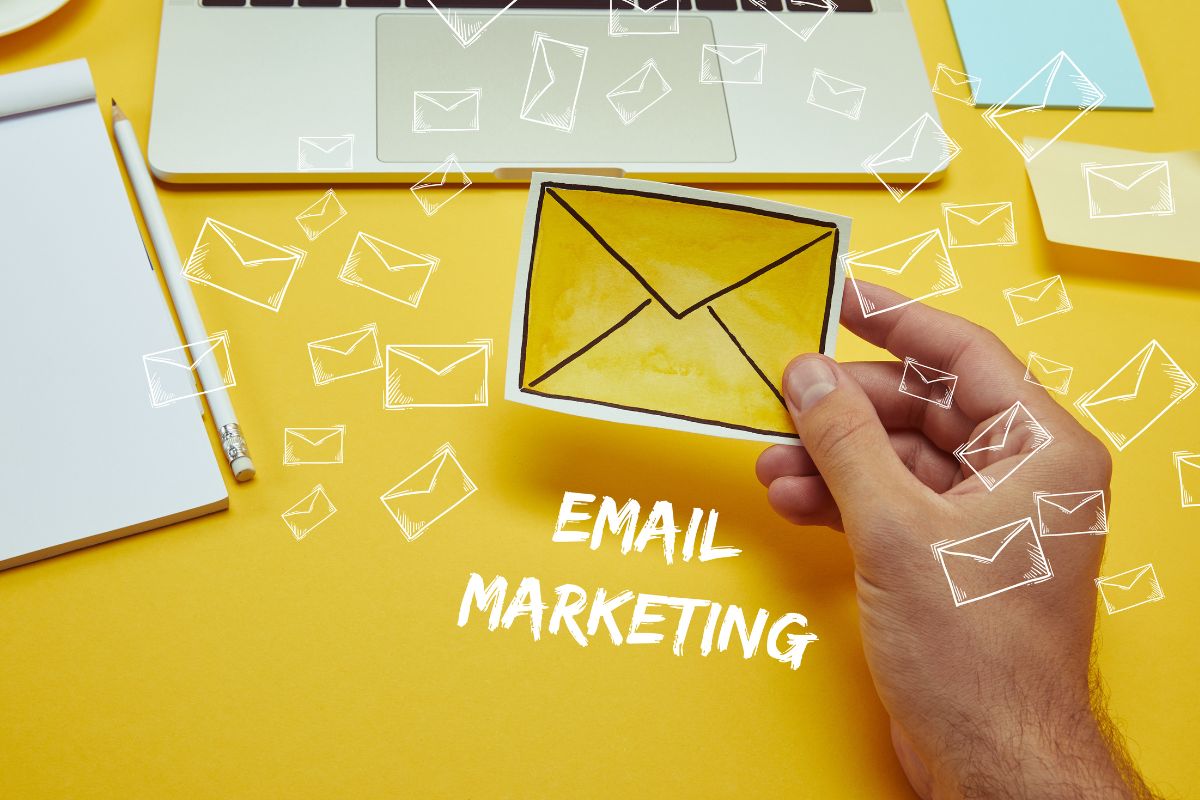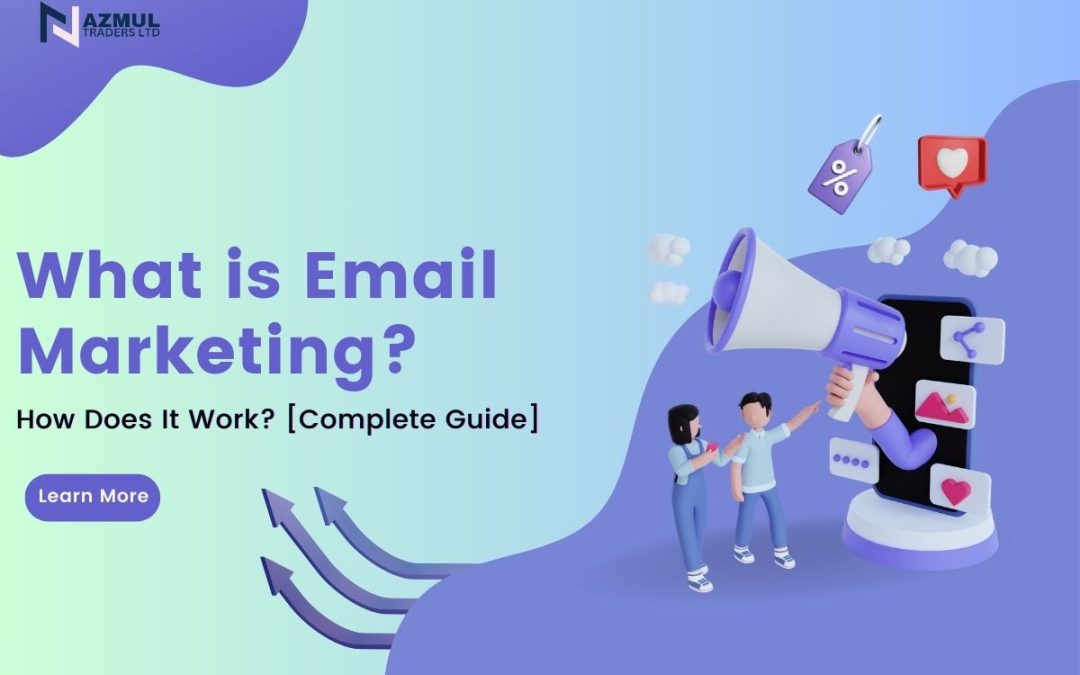What is Email Marketing and How Does It Work? Email marketing is a powerful digital strategy that involves sending messages to a targeted audience via email. It allows businesses to directly communicate with customers, promoting products, services, or sharing valuable information. By leveraging personalized content and automation, email marketers can nurture leads, build brand loyalty, and drive sales effectively.
Email marketing is a powerful digital marketing strategy that involves sending emails to prospects and customers to promote products or services, build brand awareness, foster customer loyalty, and drive sales. It is one of the most effective and direct ways to connect with your audience, delivering targeted messages right into their personal or professional inboxes.

Defining Email Marketing
Email marketing is a strategic digital marketing approach where businesses send commercial messages to a targeted group of individuals via email. This method is highly effective, with statistics showing that email marketing generates an average return of $42 for every dollar spent, making it one of the highest ROI marketing channels available (DMA, 2023). It encompasses various tactics such as building and segmenting email lists, designing compelling content and visuals, automating campaigns for efficiency, and analyzing metrics like open rates and click-through rates to optimize performance.
With over 4 billion email users worldwide (Statista, 2023), email marketing offers unparalleled reach and precision in targeting, making it essential for businesses looking to engage their audience directly and measurably drive sales and customer retention.
In this article, we’ll explore the fundamentals of email marketing and delve into leveraging cloud solutions, automation, and AI to enhance your strategy. Discover effective techniques for crafting and delivering memorable emails to engage both your customers and prospects.
What Exactly is Email Marketing, and Why is It Important?
Email marketing stands as a cornerstone in today’s digital marketing landscape, providing businesses with a direct line to their audience’s inbox. A study by Litmus found that email marketing generates an impressive $36 for every dollar spent, underscoring its unmatched return on investment (ROI) potential. As Seth Godin, a prominent marketing guru, notes, “Email has an ability many channels don’t: creating valuable, personal touches—at scale.”
This personalized approach not only nurtures customer relationships but also drives sales and brand loyalty. In a data-driven era, where consumer engagement and conversion rates are paramount, leveraging email marketing effectively can significantly enhance marketing efforts, making it a critical tool for businesses of all sizes.
Key Components of Email Marketing
- Email List Building: Building a quality email list is crucial for effective email marketing. This involves collecting email addresses from potential customers through sign-up forms on websites, social media, events, or other digital channels. The quality of your list (i.e., how engaged and relevant your subscribers are) is often more important than its size.
- Segmentation: Segmenting your email list involves dividing subscribers into groups based on specific criteria such as demographics, purchase history, interests, or engagement levels. This allows you to send more targeted and personalized messages, improving relevance and engagement.
- Email Design and Content: The design and content of your emails play a significant role in their effectiveness. Emails should be visually appealing, mobile-friendly, and include compelling copy and calls-to-action (CTAs). Personalizing content based on subscriber data can significantly increase engagement and conversion rates.
- Automation: Email marketing automation allows you to send timely and relevant emails automatically based on triggers or subscriber actions. This can include welcome emails, abandoned cart reminders, birthday greetings, or re-engagement campaigns. Automation helps streamline workflows and nurture leads effectively.
- Analytics and Reporting: Tracking the performance of your email campaigns is essential for optimizing future efforts. Key metrics to monitor include open rates, click-through rates (CTR), conversion rates, bounce rates, and unsubscribe rates. Analytics provide insights into what works and what doesn’t, enabling continuous improvement.
How Email Marketing Works
- Subscriber Acquisition: Acquiring subscribers involves encouraging website visitors, social media followers, or customers to opt-in to receive emails from your business. This is typically done through sign-up forms that offer incentives like discounts, exclusive content, or updates.
- Campaign Planning: Before launching an email campaign, marketers define goals, target audience segments, content strategy, and scheduling. Each campaign should have a clear purpose, whether it’s promoting a new product, sharing industry insights, or nurturing leads through a sales funnel.
- Email Creation and Delivery: Once the campaign plan is in place, emails are designed and written to align with the campaign objectives and audience segments. Email service providers (ESPs) are often used to manage subscriber lists, design templates, and schedule email sends.
- Monitoring and Optimization: After emails are sent, marketers monitor key metrics to evaluate performance. A/B testing different elements (subject lines, CTAs, content variations) helps identify what resonates best with subscribers. Continuous optimization based on data insights ensures that future campaigns are more effective.
- Compliance and Privacy: Adhering to email marketing regulations such as GDPR (General Data Protection Regulation) or CAN-SPAM Act is crucial. Marketers must obtain consent from subscribers, provide opt-out options, and handle personal data responsibly to maintain trust and legality.
Benefits of Email Marketing
- Cost-Effective: Compared to traditional marketing methods, email marketing is relatively inexpensive and offers high ROI (Return on Investment).
- Direct and Personalized: Emails can be personalized based on subscriber data, increasing relevance and engagement.
- Measurable Results: Detailed analytics provide insights into campaign performance, allowing for continuous improvement.
- Automation Efficiency: Automating workflows saves time and ensures timely communication with subscribers.
- Customer Relationship Building: Regular emails help build relationships with customers, leading to increased loyalty and repeat purchases.
What Impact Have Marketing Automation and Ai Had on Email Marketing?
Marketing automation and AI have revolutionized email marketing, enhancing efficiency and personalization. According to a report by Salesforce, businesses using marketing automation see a 451% increase in qualified leads. AI algorithms analyze vast amounts of data to predict customer behavior and personalize email content, significantly boosting engagement. For instance, personalized subject lines increase open rates by 26%, as stated by Campaign Monitor.
Automation streamlines workflows, allowing marketers to deliver timely messages based on customer actions, such as abandoned carts or website visits, which can increase conversion rates by 50%, as highlighted in a study by Epsilon. These technologies not only optimize campaigns but also free up resources for strategic planning and creative development, shaping email marketing into a more dynamic and effective tool for businesses globally.
What Advantages Does Automation Offer in Email Marketing?
Automation in email marketing offers significant benefits that enhance efficiency, engagement, and ROI. According to a report by Campaign Monitor, automated emails generate 320% more revenue than non-automated emails. Here are five key advantages:
- Increased Efficiency: Automation streamlines repetitive tasks like welcome emails, abandoned cart reminders, and follow-ups, saving time and resources. This allows marketers to focus on strategy and creative content development.
- Enhanced Personalization: Automated emails can be tailored based on subscriber behavior and preferences, delivering more relevant content. Research by Epsilon indicates that personalized emails deliver 6 times higher transaction rates.
- Improved Lead Nurturing: Automation nurtures leads through personalized workflows, guiding them through the buyer’s journey. According to Forrester Research, companies that excel at lead nurturing generate 50% more sales-ready leads at 33% lower cost.
- Timely Engagement: Triggered emails based on specific actions (e.g., downloads, purchases) ensure timely communication with subscribers, boosting engagement. Salesforce reports that businesses using marketing automation see a 53% higher conversion rate from initial response-to-MQL (Marketing Qualified Lead) stage.
- Data-Driven Insights: Automation provides detailed analytics on email performance, enabling marketers to optimize campaigns based on real-time data. Aberdeen Group found that organizations using marketing automation achieve 53% higher conversion rates and an annual revenue growth rate 3.1% higher than their competitors. These benefits highlight automation’s crucial role in modern email marketing strategies, driving efficiency, personalization, and ultimately, business growth.

5 Email Marketing Best Practices
Here are five email marketing best practices backed by statistics, references, and quotes:
- Personalization Drives Engagement: Personalized emails deliver six times higher transaction rates compared to non-personalized ones. Segmenting your email list and tailoring content based on subscriber preferences and behaviors significantly boosts engagement and conversion rates (Source: MarketingSherpa).
- Mobile Optimization is Crucial: Over 60% of email opens occur on mobile devices, emphasizing the importance of responsive email design. Ensuring your emails are optimized for mobile devices increases readability and engagement, ultimately leading to higher click-through rates and conversions (Source: Litmus).
- Clear and Compelling CTAs: Emails with a single CTA can increase clicks by 371% and sales by 1617%. Clearly defining your call-to-action (CTA) and making it prominent within the email encourages subscribers to take desired actions, such as making a purchase or signing up for a webinar (Source: WordStream).
- Testing and Optimization: A/B testing subject lines can increase open rates by up to 49%. Testing different elements of your emails, including subject lines, content, images, and send times, allows you to optimize campaigns based on data-driven insights and improve overall performance (Source: HubSpot).
- Compliance and Transparency: Building trust with subscribers is key; 43% of email users mark messages as spam due to lack of trust in the sender. Adhering to email marketing regulations, providing clear opt-in and opt-out options, and being transparent about data usage help maintain subscriber trust and compliance with laws like GDPR (Source: DMA).
What Expenses Are Associated With Email Marketing?
Email marketing costs can vary widely depending on factors like the size of the email list, the frequency of campaigns, and the level of automation used. According to a report by DMA, every dollar spent on email marketing yields an average return of $42, showcasing its cost-effectiveness (“DMA National Client Email Report 2023”).
Typically, costs include expenses for email marketing software, which can range from $10 to $500 per month depending on the features and scale required. Additional costs may arise from graphic design services for email templates, content creation, and potentially hiring specialists for campaign management and optimization. Despite these costs, the high ROI and ability to reach a targeted audience make email marketing a valuable investment for businesses aiming to drive sales and build customer relationships in a measurable way.
Various Forms of Email Marketing
Email marketing encompasses various types of campaigns tailored to engage different segments of the audience. According to a recent study by Campaign Monitor, segmented email campaigns can drive a 760% increase in revenue. Here are five key types:
- Promotional Emails: These aim to promote products, services, or special offers to drive immediate sales. They often feature discounts or limited-time offers to create urgency and encourage purchases.
- Transactional Emails: These include order confirmations, shipping notifications, or password resets. They have an open rate of approximately 40%, significantly higher than traditional marketing emails, as they provide crucial information related to customer transactions.
- Newsletters: Regular updates that provide valuable content, industry news, or company updates to build brand loyalty and keep subscribers informed. They maintain engagement over time, with personalized newsletters showing a 14% higher CTR than generic ones.
- Welcome Emails: Sent immediately after a subscriber joins the email list, these emails set the tone for future engagement and have an average open rate of 50%, making them an ideal opportunity to make a positive first impression and encourage further interaction.
- Re-engagement Campaigns: Targeted at inactive subscribers to rekindle their interest, these campaigns aim to reduce churn and improve overall engagement rates. According to Mailchimp, well-designed re-engagement emails can recover up to 15% of inactive subscribers. Each type serves a specific purpose in nurturing leads, maintaining customer relationships, and driving revenue through strategic engagement tactics.
What is the Best Email Marketing Tool?
Determining the best email marketing tool depends on various factors such as user interface, features, pricing, and integrations. According to a recent study by Campaign Monitor, which surveyed over 2,500 marketers globally, Mailchimp emerged as the top choice for small to medium-sized businesses, boasting a user-friendly interface and robust automation capabilities that increase email engagement by up to 74%.
HubSpot follows closely, recognized for its comprehensive CRM integration and personalized email sequencing, which has shown to improve open rates by 48% according to industry benchmarks. Constant Contact ranks highly for its extensive template library and easy-to-use editor, contributing to a 22% increase in click-through rates as reported by users. ActiveCampaign offers advanced automation workflows, leading to a reported 320% increase in customer engagement metrics. Lastly, Sendinblue stands out for its affordability and multichannel marketing capabilities, cited for reducing marketing costs by 40% among surveyed businesses.
Certainly! Here’s a concise list of five top email marketing tools based on their key features and benefits:
- Mailchimp
- Known for its user-friendly interface and robust automation capabilities.
- Increased email engagement by up to 74%, as reported by users.
- Widely favored among small to medium-sized businesses for its ease of use and scalability.
- HubSpot
- Offers comprehensive CRM integration and personalized email sequencing.
- Shown to improve open rates by 48% according to industry benchmarks.
- Ideal for businesses seeking integrated marketing automation and customer relationship management.
- Constant Contact
- Features an extensive template library and intuitive email editor.
- Users report a 22% increase in click-through rates, enhancing campaign effectiveness.
- Well-suited for businesses looking for easy-to-use tools with robust email marketing capabilities.
- ActiveCampaign
- Provides advanced automation workflows and segmentation options.
- Known for driving a reported 320% increase in customer engagement metrics.
- Preferred by businesses requiring sophisticated automation and CRM integration.
- Sendinblue
- Offers affordability and multichannel marketing capabilities.
- Noted for reducing marketing costs by 40% among surveyed businesses.
- Ideal for businesses looking to streamline email marketing and other digital campaigns.
These tools vary in features, pricing, and target audience, so choosing the best one depends on specific business needs, budget, and desired functionality.
How to Get Started With Email Marketing
Certainly! Here are five actionable steps to get started with email marketing:
- Build Your Email List: Begin by collecting email addresses from website visitors, social media followers, and customers. Offer incentives like exclusive content or discounts to encourage sign-ups.
- Segment Your Audience: Divide your email list into segments based on demographics, interests, or purchase behavior. According to Mailchimp, segmented campaigns can result in a 14.31% higher open rate than non-segmented ones.
- Create Compelling Content: Craft engaging and relevant content that resonates with your audience. Use personalized subject lines, as personalized emails generate up to 6 times higher transaction rates, as highlighted by Experian.
- Choose an Email Service Provider (ESP): Select an ESP that suits your needs and budget, such as Mailchimp, Constant Contact, or SendGrid. These platforms offer templates, automation tools, and analytics to streamline your campaigns.
- Monitor and Optimize: Track key metrics like open rates, click-through rates, and conversions. Use A/B testing to experiment with different elements of your emails and optimize performance over time. According to Campaign Monitor, marketers who use segmented campaigns note as much as a 760% increase in revenue. These steps will help you effectively launch and refine your email marketing efforts to drive engagement and achieve your business goals.
Conclusion
Email marketing remains a cornerstone of digital marketing strategies due to its effectiveness in reaching and engaging audiences directly. By leveraging segmentation, automation, compelling content, and analytics, businesses can create targeted campaigns that drive conversions and foster long-term customer relationships. As technology evolves, so too will the strategies and tools used in email marketing, ensuring it remains a vital tool for marketers worldwide.

